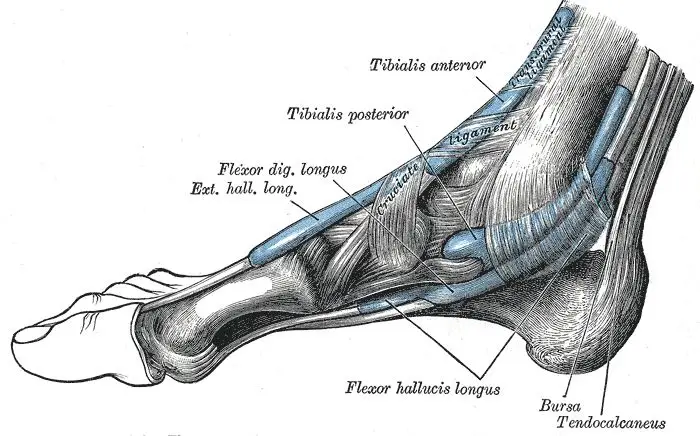ANKLE PAIN DUE TO A COMPRESSED NERVE
What is Tarsal Tunnel Syndrome?
Tarsal Tunnel Syndrome occurs when the posterior tibial nerve becomes compressed as it travels through the tarsal tunnel — a narrow passageway just below the inner ankle. This nerve provides sensation to the bottom of the foot and controls some of its muscles. When compressed, it can cause burning, tingling, numbness, or electric-shock sensations on the sole of the foot or toes.
At SoCal Foot and Ankle Doctors, we specialize in identifying the underlying causes of nerve compression and offering both non-invasive and advanced treatments tailored to each patient.

Common Symptoms
- Burning or tingling on the bottom of the foot
- Numbness in the toes or arch
- Pain that worsens with activity or prolonged standing
- Weakness or cramping in the foot
- Symptoms that may mimic Morton’s neuroma
What Causes Tarsal Tunnel Syndrome?
The most common cause is overpronation or flattening of the foot arch, which stretches and compresses the nerve over time. Additional causes include:
- Flat feet due to subtalar joint instability
- Ganglions, fibromas, or lipomas pressing on the nerve
- Varicose veins within the tarsal tunnel
- Scar tissue from previous trauma
- Diabetes or systemic inflammation
Tarsal Tunnel Syndrome is most common in adults over the age of 30 and tends to progress slowly if not treated.
How We Diagnose It
Diagnosis is based on:
- Thorough physical examination and patient history
- Tinel’s sign testing (tapping over the nerve)
- Observation of flatfoot deformity or swelling near the ankle
- In-office digital X-rays to assess foot structure
- Ultrasound or MRI (to evaluate soft tissue masses)
- Nerve conduction studies (for advanced or uncertain cases)
Other conditions that can cause similar symptoms include diabetic neuropathy, lumbar nerve compression, and poor circulation. Accurate diagnosis is critical to effective treatment.
Treatment Options for Tarsal Tunnel Syndrome
Conservative Therapies
- Custom Foot Orthotics: Realign the foot to reduce nerve strain caused by overpronation
- Calf Muscle Stretching: Reduces strain on the nerve and ankle joint
- Anti-inflammatory Medications or Vitamin B supplements to reduce irritation
- Night splints or bracing for offloading pressure
- Nerve pain medications (as prescribed for nighttime burning sensations)
Advanced Options
- Shockwave Therapy: Non-invasive regenerative therapy that stimulates healing and reduces nerve entrapment
- Steroid Injections: Temporary relief from inflammation in the tarsal tunnel
- Surgical Decompression: Reserved for severe or structural causes like soft tissue masses. Surgery may relieve nerve pressure but does not correct flatfoot, so orthotics are still required afterward
- Galvanic Nerve Stimulation or magnetic insoles as adjunct therapies
- Referral to a pain specialist for persistent nerve symptoms
Note: If nerve damage has progressed, full recovery may not be possible, but targeted treatment can significantly reduce symptoms and improve quality of life.
Why Choose SoCal Foot and Ankle Doctors?
- Located conveniently near Cedars-Sinai Medical Towers in Santa Monica
- Specialists in nerve-related foot conditions and biomechanical correction
- In-office diagnostics (ultrasound, X-ray, gait analysis)
- Customized orthotic therapy and modern regenerative care options
- Compassionate, personalized approach from a board-certified podiatrist
Don’t Ignore Nerve Pain
Tarsal Tunnel Syndrome rarely gets better on its own — and delayed treatment can lead to permanent nerve damage. If you’re experiencing burning, tingling, or numbness in your foot or ankle, schedule an appointment with SoCal Foot and Ankle Doctors today. We’ll help you get back on your feet — comfortably.
Our Docters
Our Board Certified Podiatrists
Socal Foot and Ankle doctors are committed to delivering the most exceptional treatments.

Board Certified Foot & Ankle Specialist
Office Time
Location: Santa Monica
Mon – Thur: 9:00 AM – 5:00 PM
Friday: 9:00 AM – 5:00 PM

Board Certified Foot & Ankle Specialist
Office Time
Location: Santa Monica
Mon – Thur: 9:00 AM – 5:00 PM
Friday: 9:00 AM – 5:00 PM
Request Appointment
NON-INVASIVE ADVANCED TREATMENT
BOARD CERTIFIED
FOOT & ANKLE
Surgeons
Years Experience
Happy Patients
Location
Local Partners
